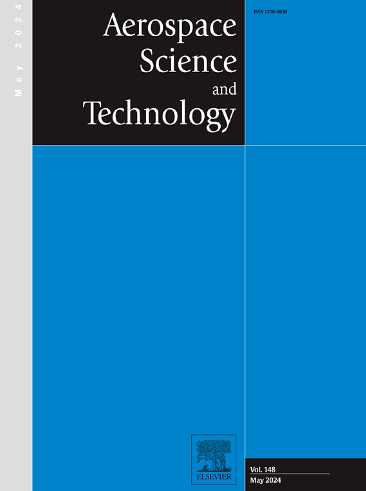Air curtains for landing gear noise reduction
IF 5
1区 工程技术
Q1 ENGINEERING, AEROSPACE
引用次数: 0
Abstract
This paper examines the implementation of air curtain nozzles to reduce the aerodynamic noise radiated from a modified scaled LAGOON landing gear and a detailed trailing-arm Main Landing Gear representing a generic Bizjet wing mounted gear provided by Dassault Aviation and Safran Landing Systems. At approach to landing, landing gear noise is still a significant contributor to environmental noise in the vicinity of airports. Progress is being made with ambitious projects which aim to develop significantly reconfigured aircraft architectures to reduce airframe noise. The current project examines a noise abatement concept which could be retrofitted to existing landing gear configurations as an interim measure or as part of a longer term solution. Flow control in the form of “air curtain” nozzles which create a fluidic shield or virtual fairing are examined. The air curtain concept was examined as a low test-readiness-level (TRL), high-risk, high-gain technology tested in the EU funded H2020 collaborative research project: INVENTOR, InnoVative dEsign of iNstalled airframe componenTs for aircraft nOise Reduction. The nozzles operate at high pressure with rows of choked-flow sub-millimeter holes. Narrow and broadband noise attenuation was achieved, with reductions of over 7 dB measured. The air curtains were examined in DLR's AWB aeroacoustic facility in Braunschweig, Germany.
用于降低起落架噪音的气帘
本文章由计算机程序翻译,如有差异,请以英文原文为准。
求助全文
约1分钟内获得全文
求助全文
来源期刊

Aerospace Science and Technology
工程技术-工程:宇航
CiteScore
10.30
自引率
28.60%
发文量
654
审稿时长
54 days
期刊介绍:
Aerospace Science and Technology publishes articles of outstanding scientific quality. Each article is reviewed by two referees. The journal welcomes papers from a wide range of countries. This journal publishes original papers, review articles and short communications related to all fields of aerospace research, fundamental and applied, potential applications of which are clearly related to:
• The design and the manufacture of aircraft, helicopters, missiles, launchers and satellites
• The control of their environment
• The study of various systems they are involved in, as supports or as targets.
Authors are invited to submit papers on new advances in the following topics to aerospace applications:
• Fluid dynamics
• Energetics and propulsion
• Materials and structures
• Flight mechanics
• Navigation, guidance and control
• Acoustics
• Optics
• Electromagnetism and radar
• Signal and image processing
• Information processing
• Data fusion
• Decision aid
• Human behaviour
• Robotics and intelligent systems
• Complex system engineering.
Etc.
 求助内容:
求助内容: 应助结果提醒方式:
应助结果提醒方式:


